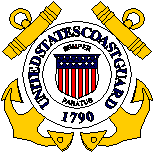
The
Final Patrol of
U.S. Coast Guard
Patrol Boat CG-245
"Belle of San
Juan"
And Ted A. Morris, Lt. Col., USAF, Retired
On November 3, 1935, the U.S. Coast Guard Patrol Boat
CG-245 sank in heavy seas at the entrance to the harbor
of San Juan, Puerto Rico, within sight of the El Morro
Fortress that guards this beautiful harbor.
CG-245 was one of two hundred and three 75-foot wooden hulled patrol boats built for the Coast Guard primarily to combat "rum runners" of the Prohibition Wars during the 1920's and 1930's. Manned by eight to ten men, they were equipped with two 400HP Sterling 6-cylinder gasoline engines, with a top speed of about 15 knots. It was possible for them to remain at sea, on duty, for about one week at a time. On the foredeck was mounted a one-pounder (37MM) naval cannon. CG-245 was built during 1924 for the Coast Guard by Gibbs Gas Engine Company of Jacksonville, Florida, at the cost of about $27,000. She was affectionately called the "Belle of San Juan" by the residents of San Juan.
Under the command of Warrant Boatswain (Bosun) S. B. Natwig that fateful day in November, the CG-245 was returning to San Juan Coast Guard Base From a coastal patrol to Point Borinquen on the Northwest corner of Puerto Rico. The weather had been calm until the afternoon when storm clouds and rough seas began forming along the north coast.
Weather reports in 1935 were practically non-existent so no warnings had been sent out.
San Juan was the nearest harbor. Weather conditions worsened, heavy rain and high seas battered the CG-245. Bosun Natwig increased speed. By late afternoon the vessel reached the sea buoy marking the entrance to the channel into San Juan. The decision was made to attempt an entry into the safety of the harbor. All hands were at their stations and the vessel secured against the crashing seas.
Suddenly a tremendous wave driven by the increasing wind broke over the stern and roared along the 75 foot length of the CG-245. Ships Cook, O. A. Williams manning an exposed lookout position was torn loose and washed overboard. Bosun Natwig attempted to maneuver his vessel to recover Williams but high waves battered the CG-245 and drove her out of the ship channel. She was in danger of being driven onto the shore near El Morro Fortress. While crew members tossed life buoys and lines in a vain attempt to rescue Williams, others prepared to drop the ship's anchor to prevent being driven ashore.
Temporarily anchored, the CG-245 was continuously battered by increasingly heavy seas. Bosun Natwig sent a radio call for assistance.
The U.S. Lighthouse Service buoy tender COLUMBINE under command of Captain Norman Manyon got underway and made several attempts to take CG-245 under tow and out of danger. The worsening sea conditions thwarted every attempt, so the decision was made to put the COLUMBINE along side the CG-245 to remove the crew. Captain Manyon successfully completed this maneuver and rescued all crew members.
In the continuing storm the COLUMBINE pulled away leaving the CG-245 anchored in the heavy seas. During the night its anchor tore loose and the CG-245 was swept out to sea. Smashed by the heavy seas, she sank..
Several days later, as the storm subsided, the body of O. A. Williams was recovered. Debris from the CG-245 was found washed up along the north shore.
In 1939 the U.S. Lighthouse Service became part of the U.S. Coast Guard and the 121-foot tender COLUMBINE became U.S. Coast Guard Cutter COLUMBINE WAGL-208.
On Good Friday, 11 April 1952, the USCG PBY-5A amphibian aircraft 48429 would land in heavy seas to rescue survivors from the crash of Pan American Clipper Flight 526-A into the shark infested waters off the north shore of San Juan Puerto Rico. The stepson of Bosun S.B. Natwig, Lieutenant Commander Jack Natwig, USCG, co-pilot of aircraft 48429, would dive overboard into the waters off the north shore of San Juan Puerto Rico to save the life of a teen age boy, survivor of Flight 526-A.